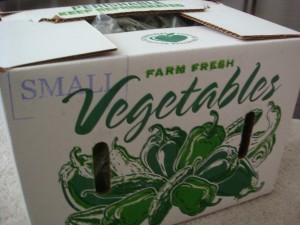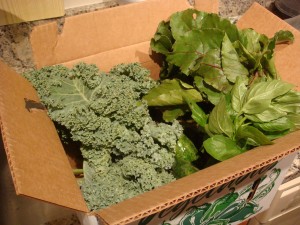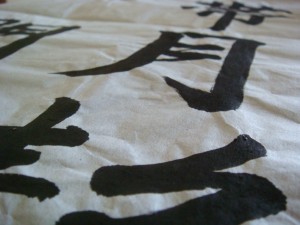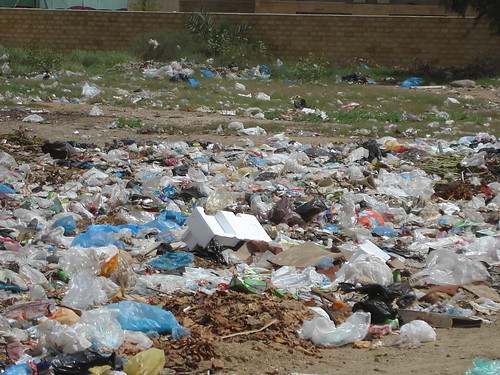Washington DC’s Capital Bikeshare program has been a resounding success since its launch in the fall of last year. There are now 1100 bikes spread out at over 110 stations throughout DC and Arlington, VA. Capital Bikeshare recently announced the addition of 32 new bikeshare stations within the District, and Arlington County is currently reviewing where to put in several new stations along the Rosslyn-Ballston Metro corridor. There are so many ways in which DC’s Bikeshare system has been done right, from the design of the bikes to ease of use for customers that it makes a great example for other US cities to follow. My only wish is that they expand with stations in Shirlington (south Arlington), which will likely be Arlington’s next step after stations are complete in the Arlington Metro corridor. Here’s a video from Streetfilms documenting some of the Bikeshare’s success:
Sustainable Eating: The CSA
 Over the past few months my girlfriend and I have been looking for ways to live a more sustainable lifestyle. I decided to forgo buying a car (using a combination of my bicycle and public transportation instead), found new ways to clean around the house using non-toxic ingredients and recycled materials, and now have joined a community-supported agriculture (CSA) program to source part of our food locally. There are all sorts of CSAs out there (meat, dairy, fruit) and various size shares available, depending on the farm, but we chose to keep it simple with a small vegetable share for our first CSA experience.
Over the past few months my girlfriend and I have been looking for ways to live a more sustainable lifestyle. I decided to forgo buying a car (using a combination of my bicycle and public transportation instead), found new ways to clean around the house using non-toxic ingredients and recycled materials, and now have joined a community-supported agriculture (CSA) program to source part of our food locally. There are all sorts of CSAs out there (meat, dairy, fruit) and various size shares available, depending on the farm, but we chose to keep it simple with a small vegetable share for our first CSA experience.
Here are two reasons we joined a CSA and what we’ve enjoyed about it so far:
- Fresh LOCAL Food
We try to eat fresh foods as much as possible, but finding locally-sourced food is a bit more of a challenge. I’ve wanted to join a CSA for many years, but with the move to Japan and being a broke college student before that, it never was a possibility. However, now, for five months of the year we have our vegetables traveling 110 miles from southern Pennsylvania to our table. This isn’t as close as I wanted it to be (we signed up late, so this was the closest CSA I could find with shares still available), but it’s certainly more sustainable than the 1400-mile average that most food travels before it gets to your kitchen. - Trying Out New Foods
Getting a box of in-season vegetables forces us to try out new veggies that we wouldn’t normally have purchased. For example, prior to joining the CSA, the only time I had ever bought a beet was as an accessory to my Dwight Schrute Halloween costume. Sure enough we got a bunch of beets in our first box of veggies, so I got online and found a delicious recipe for roasting beets- we ate every part of the beet!
Every Thursday we pick up our box from our local drop point and it’s always exciting to see what’s inside for the week. We’re looking forward to more fresh, locally grown foods coming our way, maybe adding a fruit share, and we’re hoping to find a CSA for other seasons as well! Has anyone else had any experiences with CSAs? Please leave a comment!

Few Spots Remaining for Japanese Calligraphy Course in Arlington, VA!
There are five spots left for my Intro to Japanese Callligraphy course in Arlington. If you live in the area (or know someone who does) come check it out! The class starts Thursday, May 5th and will be held at Washington-Lee High School.
Interested? Follow this link to sign up!
Wonderful Short Animated Film for World Water Day
Yesterday was World Water Day. Freshwater shortages are going to become a serious issue in the near future and have been a problem in California and along the Chattahoochee River in the Georgia, Alabama, and Florida tri-state area. In recognition of World Water Day, Bit Films released The Incident at Tower 37 online yesterday. It’s a unique animated short film that takes a look at the human impacts on ecosystems. The film has won many awards at film festivals throughout the world. Enjoy!
The Tragedy in Miyagi, Japan

Koizumi region around Tsuya river. The trainline has collapsed in the foreground. The car bridge in the background is also destroyed.
It is a bit surreal to watch the videos of the recent earthquake and subsequent tsunami in Japan. There are images of places where I used to hang out flooding with waves 10m high, and photos of roads I’ve driven on a thousand times split in half and with ships beached on them. It’s been difficult to see homes washing away and cars floating down the streets. Most heart-wrenching of all has been the inability to make contact with those affected, my friends, former students and coworkers. People whom I considered family for the three years I lived in Motoyoshi. A great deal of them have likely lost their homes. Koizumi, the southern most village in Motoyoshi, is a very small community right along the water. I surfed there many times. The train line is destroyed in Koizumi, the bridge carrying it over Tsuya river having been knocked down. Many homes were in these low-lying areas near the river and coastline.
Kaigan-shokudou is a restaurant owned by the family of Kazuma, a kindergartner I taught in Koizumi. It was no more than a hundred yards from the coast. We (the school staff) would often order bento boxes for lunch from Kaigan-shokudou on the days that there was no kyushoku (school lunch). I knew when Kazuma had told his family about me and the games we played at the kindergarten (my work at kindergartens consisted of about 10% English teaching, and the rest was playing games while tossing out relevant English vocabulary) because after that I always got extra food in the lunches I ordered. I can only hope that he and his family are safe. That’s been the hardest part to handle through all this, the not knowing. Continue reading
The Biomimetic City and Sustainability
There is a lot we can learn from nature, and that is what the science of biomimicry is all about. Buildings eat up the majority of our resources and thus are the area where we can effect the most change.
But it’s also not enough simply to just make a couple of green buildings. Entire cities can be planned based on the ecology of the landscape so as not to degrade the natural environment.
Over at 2ndgreenrevolution today, I discuss how using biomimicry in buildings (ex: a building modeled after a termite mound) and cities can bring us closer to a sustainable living. Check it out here.
Turn Waste Plastic Into Fuel
Plastic is everywhere. It has found its way into all sorts of products that we use regularly. You can now buy a plastic toy in plastic packaging at the store and they’ll put it into a plastic bag for you. How convenient! But what happens to all that plastic? A plastic bag that goes to a landfill will take 10 to 20 years to degrade. A lot of the plastic doesn’t make it to the trash though, and now we have a garbage pile in the Pacific Ocean estimated to be twice the size of Texas. Yes, that is huge.
Well, now a Japanese inventor by the name of Akinori Ito has created a machine that turns waste plastic back into oil, and with one extra refining step it can be turned into gasoline. Further good news: the machine uses barely any energy. Imagine taking all your plastic waste (shopping bags, wrappers, takeout containers, etc) and turning it into a gallon of gas that you then put into your car. This doesn’t relieve us from our oil dependency, but it would help us keep tons of plastic from contaminating our soils and waterways. It would also let us reuse all the wasted plastic from ‘disposable’ products that are used once and tossed away.
Language Study: Learning Kanji
 There are many ways to approach the daunting task of learning the 2,136 joyo (常用/regular use) kanji of the Japanese language. The first thing to remember is that this will be a process; there’s a reason why Japanese is ranked in the third and most difficult group of languages to learn (for native English speakers) according to the US State Department, so don’t get frustrated if you aren’t making progress as fast as you had hoped. I have tried to organize and summarize some of the most popular studying approaches to save you time once you begin your quest to learn Japanese kanji.
There are many ways to approach the daunting task of learning the 2,136 joyo (常用/regular use) kanji of the Japanese language. The first thing to remember is that this will be a process; there’s a reason why Japanese is ranked in the third and most difficult group of languages to learn (for native English speakers) according to the US State Department, so don’t get frustrated if you aren’t making progress as fast as you had hoped. I have tried to organize and summarize some of the most popular studying approaches to save you time once you begin your quest to learn Japanese kanji.
Secondly, no one way is necessarily better than the other. However, there are methods that are more suitable depending on how you use (or plan to use) Japanese in your daily life. Keep in mind your own particular study habits, and how you tend to learn the best. These are the four most common ways to tackle learning kanji based on my own experiences studying in the US and in Japan:
- By order of frequency
- The textbook
- The Japanese Way
- The Heisig Method
Before we jump in, here are some general tips on making whichever method you choose more effective:
- Read A LOT
The more you are exposed to different characters in various compounds and their situational usage, the more comfortable you will feel with the characters and the language. Japanese texts and reading passages can be found anywhere. After acquiring a base of 100-150 characters you should be ready to comprehend some simple articles. There are several news websites aimed at Japanese children that are great places to get articles like Asahi Kodomo and Yahoo Kids. Try the regular Asahi site or Yomiuri for advanced readers. Some other resources are Amazon.co.jp, your textbook (I highly recommend the Minna no Nihongo textbooks), and the library (good libraries should have a section of books in foreign languages). - Learn to Write the First 250 Characters
Each character is made of radicals and various similar components. After you learn the basic kanji and their proper stroke order you don’t need to learn how to write the rest. The more complicated characters will be made through combinations of the basic components. Stroke order is important to learn when you first begin, because not only will it help you when you begin to write more complicated kanji but it just looks funny if you write kanji in the incorrect order. It would be similar to seeing someone writing an ‘S’ in English and starting from the bottom and snaking your pencil line up. It’s good to learn how to write the basics, but beyond that you should not concern yourself too much with writing the characters unless you plan on handwriting letters in Japanese for the rest of your life. With computers and cell phones you aren’t likely to be writing the characters much, and if you do ever need to you’ll know how to write all the basic components of each character. - Know the Readings
When you learn a new kanji make sure you know ALL of the readings for that character. This will make learning new kanji compounds in the future much easier. Invest a little more time now and save yourself the headaches later on. Continue reading
Detroit: Finally Some Recognition For What Is Happening
The city of Detroit often comes under the radar of the national media for what is not happening in the city. Ruin, degradation, and decline are some of the common terms that are used to describe the city. Yet, more and more people are realizing the city’s potential. The city already has a vast deal of urban farms, and soon will add the world’s largest urban farm to that resume. And there are artists from all over the world seeing the opportunities that are available in the city, which is why it was great to see this 30-minute documentary from Palladium Boots (hosted by none other than Johnny Knoxville) talking about what is going on in Detroit. Check it out.
How to Make $80 (or more) Per Hour By Applying Minimalist Techniques
I’ve moved twice in the past month and a half and have learned a few things in the process: summers are real hot in D.C., your bags should always fly free, second chances don’t come often, and the more stuff you have the harder it is to move around. I have spent part of the last few weeks trying to cut down on the amount of stuff I own by applying minimalist principles to keep possessions to a manageable amount (i.e. an amount that fits in two suitcases). I’ve cut this extra weight by recycling, donating, gifting, and selling various possessions. For selling things I have primarily used eBay, although there are various other options (Craigslist, Amazon, etc). Here is the step-by-step process I used to make $60 yesterday selling old basketball trading cards for only 45 minutes of work. Continue reading

